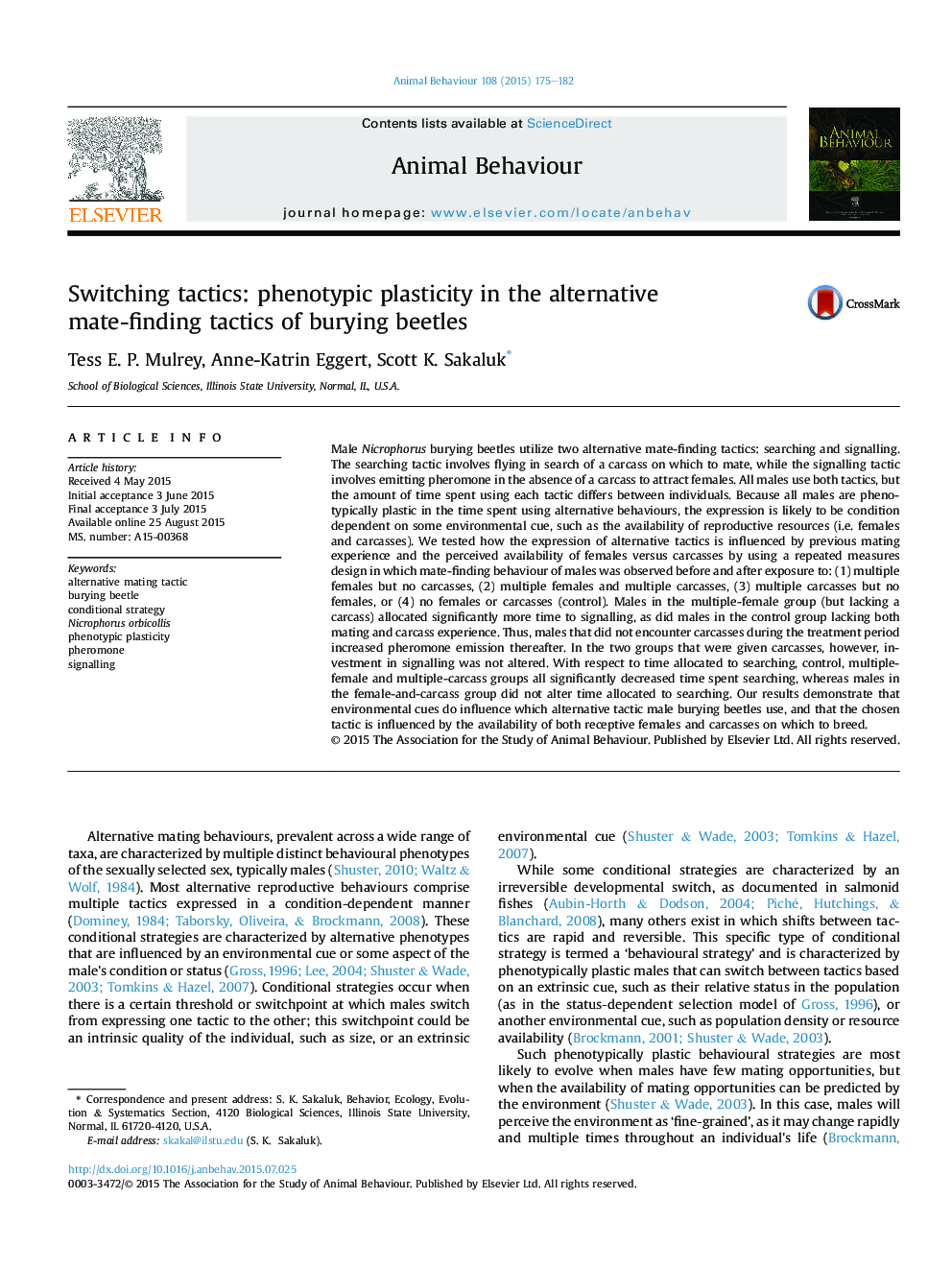| کد مقاله | کد نشریه | سال انتشار | مقاله انگلیسی | نسخه تمام متن |
|---|---|---|---|---|
| 8489680 | 1552220 | 2015 | 8 صفحه PDF | دانلود رایگان |
عنوان انگلیسی مقاله ISI
Switching tactics: phenotypic plasticity in the alternative mate-finding tactics of burying beetles
ترجمه فارسی عنوان
تاکتیک های سوئیچینگ: پلاستیکی فنوتیپیک در روش های جایگزین مکتب کشف سوسک
دانلود مقاله + سفارش ترجمه
دانلود مقاله ISI انگلیسی
رایگان برای ایرانیان
کلمات کلیدی
ترجمه چکیده
سوسک های دفن زنبور نیکوفوروس با استفاده از دو تاکتیک جادویی جایگزین: جستجو و سیگنال کردن. تاکتیک جستجو شامل پرواز در جستجوی لاشه است که به آن متصل می شود، در حالی که تاکتیک سیگنالینگ شامل انتشار فمور در غیاب لاشه برای جذب زنان است. همه مردان از هر دو تاکتیک استفاده می کنند، اما مقدار زمان صرف شده با استفاده از هر تاکتیک بین افراد متفاوت است. از آنجایی که همه مردان در زمان صرف شده با استفاده از رفتارهای جایگزین پلاستیک فنوتیپی هستند، احتمالا این عبارت به شرایط زیست محیطی وابسته است مانند دسترسی به منابع تولید مثل (به عنوان مثال زنان و لاشه). ما آزمایش کردیم که چگونه بیان تاکتیک های جایگزین تحت تأثیر تجربه قبلی جفتگیری و در دسترس بودن زنان در مقابل لاشه با استفاده از یک طراحی اندازه گیری مکرر که در آن رفتار متیقین مردان قبل و بعد از قرار گرفتن در معرض: (1) چند زن، اما بدون لاشه، (2) چند زن و چند لاشه، (3) چند لاشه، اما بدون زن، و یا (4) بدون زن و یا لاشه (کنترل). مردان در گروه چند زن (اما بدون لاشه) به طور قابل توجهی زمان بیشتری را برای سیگنالینگ اختصاص دادند، همانطور که مردان در گروه کنترل نبودند و تجربه دوسویه و لاشه نداشتند. بنابراین، مردانی که در طی دوره درمان لاک پشتی نداشتند، پس از انتشار فرمون افزایش یافت. با این حال، در دو گروه که لاشه داده شده بود، سرمایه گذاری در سیگنال تغییر نکرده بود. با توجه به زمان اختصاص داده شده به جستجو، گروه کنترل، چند زن و چند لاشه، به طور قابل توجهی زمان صرف شده برای جستجو را کاهش داد، در حالی که مردان در گروه ماده و لاشه، زمان اختصاص یافته به جستجو را تغییر ندادند. نتایج ما نشان می دهد که نشانه های زیست محیطی تاثیر می گذارد که سوسک های سوسک های مردانه تاکتیکی را استفاده می کنند و تاکتیک انتخاب شده تحت تأثیر دسترس پذیری زن و مرد گیرنده قرار می گیرد.
موضوعات مرتبط
علوم زیستی و بیوفناوری
علوم کشاورزی و بیولوژیک
علوم دامی و جانورشناسی
چکیده انگلیسی
Male Nicrophorus burying beetles utilize two alternative mate-finding tactics: searching and signalling. The searching tactic involves flying in search of a carcass on which to mate, while the signalling tactic involves emitting pheromone in the absence of a carcass to attract females. All males use both tactics, but the amount of time spent using each tactic differs between individuals. Because all males are phenotypically plastic in the time spent using alternative behaviours, the expression is likely to be condition dependent on some environmental cue, such as the availability of reproductive resources (i.e. females and carcasses). We tested how the expression of alternative tactics is influenced by previous mating experience and the perceived availability of females versus carcasses by using a repeated measures design in which mate-finding behaviour of males was observed before and after exposure to: (1) multiple females but no carcasses, (2) multiple females and multiple carcasses, (3) multiple carcasses but no females, or (4) no females or carcasses (control). Males in the multiple-female group (but lacking a carcass) allocated significantly more time to signalling, as did males in the control group lacking both mating and carcass experience. Thus, males that did not encounter carcasses during the treatment period increased pheromone emission thereafter. In the two groups that were given carcasses, however, investment in signalling was not altered. With respect to time allocated to searching, control, multiple-female and multiple-carcass groups all significantly decreased time spent searching, whereas males in the female-and-carcass group did not alter time allocated to searching. Our results demonstrate that environmental cues do influence which alternative tactic male burying beetles use, and that the chosen tactic is influenced by the availability of both receptive females and carcasses on which to breed.
ناشر
Database: Elsevier - ScienceDirect (ساینس دایرکت)
Journal: Animal Behaviour - Volume 108, October 2015, Pages 175-182
Journal: Animal Behaviour - Volume 108, October 2015, Pages 175-182
نویسندگان
Tess E.P. Mulrey, Anne-Katrin Eggert, Scott K. Sakaluk,
